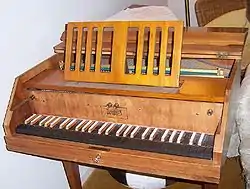Johann Christoph Neupert
Neupert is the name of a German manufacturer of keyboard instruments based in Bamberg. It takes its name from its founder, Johann Christoph Neupert.
Family and Business
Neupert was born on 8 December 1842 in Münchberg (Bavaria) and died on 7 September 1921 in Bamberg at the age of 78. After attending a vocational school in Wunsiedel, he apprenticed as an instrument maker in a factory in Oldenburg. After a few years of activity in Germany and abroad - among others at Johann Baptist Streicher in Vienna - he founded his own piano manufacturing company, Hof-Pianofortefabrik J.C. Neupert in 1868 in Münchberg; this was transferred to Bamberg in 1874 due to the rapid growth of his business. Subsidiaries were then established in Nuremberg, Bayreuth and Munich.
In 1918, the company was passed on to his three sons, Fritz (1872-1952), Reinhold (1874-1955) and Julius (1877-1970). The management was then taken over by the descendants Alfred (1900-1970), Hanns (1902-1980), Arnulf (1904-1982) and today Hanns' son Wolf Dieter (born 1937).
In addition to pianos, the Neupert company was among the first to produce harpsichord, clavichord and fortepiano from the beginning of the 19th. Under Hanns's leadership, this orientation was quickly reinforced; the firm was renamed Manufaktur für historische Tasteninstrumente and acquired a worldwide reputation. After producing "modern" instruments (metal frames, 16-foot stops, pedals, etc.), the company then turned its attention primarily to traditionally made instruments. Hanns Neupert was a scholarly author of several works on the harpsichord, among them "Das Cembalo" (1933). The total cumulative production today amounts to more than 2,0000 instruments.
Neupert was a passionate collector of early keyboard instruments. His collection was augmented by his descendants and became one of the most important private collections in the world. It has been on display at the Germanisches Nationalmuseum in Nuremberg since 1968.
Among the pianists who played on Neupert concert pianos are Max Reger, Elly Ney, Walter Braunfels, Edwin Fischer, Wilhelm Backhaus and Michael Raucheisen.
The Neupert harpsichords

Neupert was one of the most important and the first German makers of "modern" harpsichords built in series (Serien Instrumente) on the principle of a massive and heavy body (RastenKonstruction), without bottom, at the antipodes of historical harpsichords. These instruments dominated the world market until the 1970s - not, some say, because of an alleged technical or sonorous superiority, but rather because of a clever commercial policy; Wolfgang Zuckermann thus notes:[1] It will, of course, be easy for anyone to cite one particular player or critic praising the German factory instruments, but such isolated instances do not point to a consensus. Moreover, there are sometimes excellent reasons why such praise is given; in Germany, highly respected professors unashamedly accept commissions from the manufacturers, and players are often forced to use a particular make instrument because it is the only one available in a given location, or the only one than can be serviced free of charge.. The tide then turned to the benefit of craftsmen committed to the principles of traditional craftsmanship, to which Neupert eventually partially rallied, forced and coerced, with the help of Claude Mercier-Ythier. In 2009, the firm still includes in its catalogue, alongside "traditional" instruments, the modern models now so decried: Telemann, Couperin, Cristofori and Bach.
However, the Neupert Manufacture has been able to rebuild a large part of its range of plucked-stringed instruments in the historical style: see, for example, the photo of the Italian Venetian polygonal virginal shown on the right under the photo of the Neupert-Zenti spinet:
Another historical reference in Neupert's work is the construction of the Neupert-Zenti spinet in connection with the Italian maker Girolamo Zenti who introduced the wing-shaped spinet in Italy around 1637. This Neupert instrument is equipped with a 440/415 Hz transposer. See on the right above the Italian virginal Neupert:
Bibliography
- Wolfgang Zuckermann, The Modern Harpsichord: twentieth century instruments and their makers.[2] October House, New York, 1969, ISBN 0-80790-165-2
References
- op.cit. 73
- The Modern Harpsichord: twentieth century instruments and their makers on WorldCat